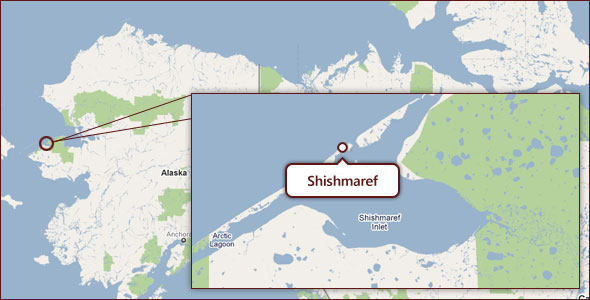
Shishmaref is a barrier reef Island in the Chukchi Sea, just north of the Bering Strait. An Inupiaq Eskimo village of about 600 residents, it is one of the largest villages on the Seward Peninsula.
While artists in Shishmaref work with much of the same materials as other area villages, such as ivory, sealskin, and whale baleen, they are most known for whalebone carving. The use of old or fossilized whalebone as a medium for contemporary art began in the 1970s and has since flourished. Whalebone carving has come to define the art community of Shishmaref. As in other Alaskan villages, the income from arts and crafts is vital as full-time good paying jobs are few and far between. For some carvers it is the primary source of income, for others an important supplement to regular work.
Common subjects of whalebone carving include figures engaged in traditional activities such as hunting, fishing, drumming and dancing, as well as "transformation" pieces which depict beings in a part human, part animal abstraction. Almost every piece is defined and embellished with baleen and ivory inlay. Most Shishmaref carvers began honing their craft from a young age, learning primarily from watching other carvers in their family.
While it is men who do most of the whalebone carving, the women of Shishmaref are some of the most talented and prolific skin sewers on the Seward Peninsula. They sew everything from basic, pattern-based ornaments to elaborate dolls that incorporate a multitude of natural materials. Shishmaref is home to the only professional tannery on the Seward Peninsula. The tannery helps create a self-sufficient, community-based system where after animals are harvested, skins and hides can be prepared for use. The tannery also helps facilitate the sewing and sale of traditional sealskin slippers.
Erosion in Shishmaref: a village on the verge of extinction
Due to warming temperatures Shishmaref is being threatened by unusually strong storms, causing flooding and erosion of the village shoreline at a rate of about ten feet each year. Without early buildup of shoreline pack ice, Shishmaref is more vulnerable to erosion caused by storms in Ocotber and December. The negative impacts of climate change in Shishmaref include melting permafrost, a rise in sea level, and a delay in the freeze up of the Bering Sea. This delayed freezing and thinner ice limits the hunting of traditional game such as seals, forcing residents to become more dependent on highly processed Western foods that are shipped in at great cost. It is estimated that as a result of erosion, the village site will be lost to the sea in about fifteen years. Residents of Shishmaref have decided to relocate to a new village site in an effort to save their community and way of life. The estimated cost of the move is 180 million dollars.
In 2008 Dutch filmmaker Jan Louter was so moved by the plight of the Shishmaref Inupiaq that he created a documentary on the erosian and ongoing move. Watch the full web documentary at the Last Days of Shishmaref film website.
VIEW WORK FROM SHISHMAREF HERE.






